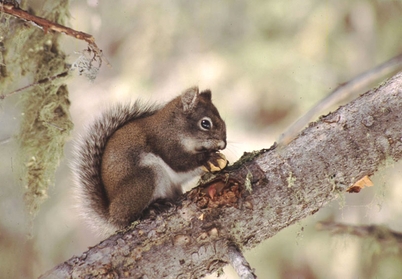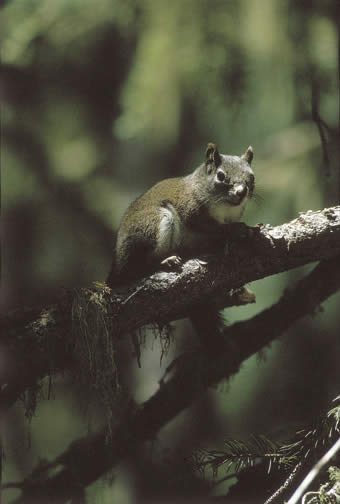Mount Graham Red Squirrels

Red squirrels are a common sight in wooded rural and suburban areas throughout the continental United States, Alaska, and Canada. Despite the disappearance of millions of acres of the woodlands they once inhabited, most types of squirrels have managed to thrive. Yet a few of these seed-loving rodents are now dangerously rare. The Mount Graham red squirrel of the Pinaleno Mountains of Graham County in southeast Arizona is at risk.
The squirrels occupy Mount Graham and Webb, Hawk, High, Emerald, and Heliograph Peaks in the Pinalenos. Scientists first collected these small mammals from the mountains in 1894. By 1965, this mammal was thought to be extinct.
A few years later, some squirrels were found, and today there may be only about 200 of these small survivors. The squirrel is on the Arizona Game and Fish Department's list of threatened native wildlife in Arizona and is classified as "endangered" by the federal government.
Like other squirrels, the Mount Graham type belongs to the order Rodentia, which includes mice, skunks, hamsters, beavers, and porcupines. In common with all rodents, the squirrel has four long, chisellike teeth built for gnawing the plant foods that make up its diet.
The Mount Graham squirrel is tiny, weighing a mere 8 ounces (224 grams) and measuring about 8 inches in length, with a 6-inch long fluffy tail. Unlike many other squirrels, the Mount Graham species does not have a white-fringed tail. Females and males look much alike; they are grayish brown in color and have rusty and yellowish markings along their backs. Their underfur is white, with a dark line running through it during the summer.
Coniferous, or cone-bearing, trees, abundant on the Pinalenos, are used by the squirrel for bothhousing and food. The squirrels build their nests in tree cavities or in crotches against the trunks. They eat the seeds of pine, fir, and spruce cones, along with mushrooms, fungi, and other plants. When danger, in the form of a raptor or weasel, appears, the squirrels seek refuge in tree cavities.
Observers have noted that the squirrels mate and become pregnant in the spring or early summer. Babies are born from late spring to late summer. Females may produce one to two litters a year, with three to four young in each litter.
A distinguishing feature of these squirrels is that they do not chatter like other squirrels. The Mount Graham squirrel is silent except when facing danger. At those times, it makes an unusual explosive, ratchetlike call that has been described as a chr-r-RR-RR sound. Scientists think that because these squirrels have lived apart from most other squirrels for thousands of years, they had less need to vocalize.
Active year-round, the squirrels are awake in the daytime and sometimes on moonlit nights. During a heavy storm, the squirrels may retreat to their nests. In the wintertime, they make tunnels under the snow to reach their food supply.
An Unusual Habitat
Rising above the desert of southeast Arizona, Mount Graham is 10,720 feet high. It is what scientists call a "biologically unique area," for on its peaks live eighteen species and subspecies of plants and animals that exist nowhere else on earth. A spruce-fir forest at the summit is the home of the Mount Graham red squirrel.
Other animals sharing this lofty habitat are the Mexican spotted owl and the Apache trout, both considered to be threatened with extinction. The Pinaleno pocket gopher, long-tailed vole, and northern goshawk are considered to be vulnerable to extinction, though not yet threatened.
Some 11,000 years ago, at the end of the most recent ice age, the Pinaleno Mountains became separated from other mountains in the region. As sheets of ice moved northward, the steep peakswere left isolated, with spruce-fir forests growing on their tops. Below, a desert, later called the Sonoran Desert, took shape.
Those insects, birds, reptiles, and mammals that could not survive in the dry desert heat found a home on the mountain peaks. They were an unusual assortment, made up of animals that had originated from the north and those that had come from Mexico. Among these was the species of red squirrel now called the Mount Graham. The red squirrels became adapted to life on the mountain. The thick canopy of spruce and corkbark fir trees and old growth forest on the mountain provided the humidity and other conditions they needed to survive.
The squirrels have their own important role in the ecosystem. Their use of cones helps with theplanting and sprouting of seeds throughout the forest. They may also scatter fungi throughout the forest as they eat portions of those plants and excrete spores that they cannot digest. As the spores make contact with tree roots, they germinate and grow.
Challenges To Survival
For centuries, the red squirrels lived quietly along the mountain slopes. At one time, they made their homes as far down as 6,500 feet above sea level. Occasionally, hunters killed some squirrels. Some trees were cut down, starting in the 1800s. Then, in the 1930s, loggers began vigorously harvesting the rich forests in the mountains which included oak, ponderosa pine, and Douglas fir on the lower slopes.
Logging pushed the red squirrel higher up the mountain. During the 1940s, a new threat arrived. The tufted-eared, or Abert, squirrel was brought into the lower areas of the mountain to live and breed for the benefit of hunters. As their habitats became more crowded, the Mount Graham squirrels relocated even higher up the mountain.
As the squirrels worked to adjust to a shrinking habitat, some continued to die from naturally occurring problems-seasonal droughts, lightning fires, and a lack of food. Squirrels can also die from viral illnesses and a disease called tularemia, but scientists are not sure which diseases are present among the Mount Graham population.
Although predators of the squirrel include the black bear, coyote, bobcat, peregrine falcon, red-tailed hawk, spotted owl, great horned owl, and reptiles such as rattlesnakes and the gopher snake, the Arizona Game and Fish Department has found that few red squirrels are killed by predators.
Thus the worst threat to the squirrels remains the destruction of their habitats, which deprives them of nesting places and food. When the trees have been cut from an area, the squirrels leave. As fewer squirrels inhabit smaller, more isolated areas, reproduction becomes a problem, as it is for the manatee, bowhead whale, and Florida panther. A reduced choice of mates means less genetic diversity. The traits in a shrinking gene pool may not be broad enough to produce hardy offspring.
Saving The Mount Graham Squirrel
During the 1980s, it became clear that the Mount Graham squirrel was in danger. Only a few squirrels were being seen each year. Squirrel hunting on the mountain was therefore banned. The area in which Mount Graham is found, now called the Coronado National Forest, was designated as protected federal land.
Conservationists urged that the old growth conditions of the land be restored and that no logging be permitted on the land above 9,000 feet where the squirrels now live. They also advocated that an area be set aside for wildlife and that no roads, campers, or human activity be permitted there.
One long-term plan will allow more trees in the Coronado National Forest to grow to maturity. The Arizona Game and Fish Department has recommended that no timber be harvested on slopes from the northwest to the east to allow more stands of spruce-firs, Douglas firs, and white firs. An increase in the number of cone-bearing trees should also help the squirrels to survive.
As these plans take shape, the squirrels are being studied to determine their actual population and to find out if they return to forests that have been allowed to renew themselves. Scientists are also trying to determine what effect other kinds of squirrels have on the Mount Graham type.

A New Threat
With high elevation and clear overhead skies, the Mount Graham area has been called a perfect place for stargazing. In the early 1980s, the University of Arizona proposed building a $200 million astronomical facility on Emerald Peak.
The university planned to set up seven telescopes on an area of about 7 to 8 acres. Eventually, there would be eighteen telescopes on peaks and knolls over a 3,500-acre area that would include most of the land above 400 feet on Mount Graham and the other Pinaleno peaks. Supporting facilities would also be built: a dormitory, workshops, garages, and a visitor center.
A controversy immediately erupted over the proposed Mount Graham International Observatory. Opponents, including biologists and botanists, said the observatory would destroy the animals and plants in this critical habitat, particularly those on the summit. At least 113 of the remaining Mount Graham squirrels live in this area. Some organizations that had planned to be part of the telescope project (the Smithsonian Institution, Ohio State University, and the University of Chicago) withdrew, citing environmental reasons.
The University of Arizona and its partners, Germany's Max Planck Institute, the Arcetri Observatory of Italy, and the Tucson-based Research Corporation, say that an observatory can co-exist with wildlife.
Officials from these groups claim that scientific research conducted from this site would help us to understand more about the origins of the universe. The university says that this area has already been logged and is used by people (Bible classes, for example) every summer. Some also say that Mount Graham squirrels may not be crucial in any way to our planet.
In the late 1980s, the observatory project went forward despite objections. Two telescopes were set up in the Pinalenos, and a third site was selected in the forest near Emerald Peak. In 1988, some of the university's proposals were reviewed by the National Park Service, which denied some and approved others with restrictions.
But then Congress passed a controversial act that exempted the three telescopes from the National Environmental Policy Act and the Endangered Species Act. A telescope called the Columbus, the largest so far, was slated to be put up about a half mile from the site that had been selected on Emerald Peak. With it would come a new road through the northernmost forest, segmenting it still further.
The university said that building on this new site would pose less harm to the squirrels than the original Emerald Peak site, but opponents point out that other living things are also at risk. The new site has the highest plant diversity in the Pinalenos. Also, any telescope located on this exposed peak could be seen from a distance, possiblv frightening animals away.
During the early 1990s, opponents to the project formed a group called the Mount Graham Coalition and continued to protest bitterly. They claimed that Congress had based its ruling on false information about the survival prospects of the Mount Graham squirrel and asked the ForestService to review the situation.
The coalition, which included local Audubon chapters, with support from the National Wildlife Federation, Sierra Club, and some University of Arizona students, hoped for legislation that would halt the new telescope and require that another study be done before any more habitat was destroyed. They also asked that the existing telescopes be removed. To support their case, they claimed that the Hubble Space Telescope, launched from a space shuttle, makes such earth-based astronomy projects obsolete and unnecessary.
Local Native Americans have also protested the observatory. The San Carlos Apaches consider Mount Graham a sacred site in their religion-the home of the mountain spirits who taught their tribe to hunt. They claim the observatory violates the Native American Religious Freedom Act of 1968 and the National Historic Preservation Act. In 1992 , a court ruled in favor of the University of Arizona, but the Apaches have appealed that decision.
The debate over the Mount Graham Observatory shows how broadranging and divisive environmental issues can be. Some organizations, such as the Smithsonian Institution, have long supported both environmental concerns and astronomy. They support Native American interests, too. One issue at the heart of the matter is whether more knowledge about the stars and other astronomical subjects is worth the potential loss of animal and plant species and unique natural settings. To those who say it is not, the answer is to avoid tampering with the peaks of Mount Graham and allow the squirrels and other living things to exist as they did years ago.
Terry B. Johnson of the Arizona Game and Fish Department has said that management of Mount Graham "must preclude anything that negatively impacts spruce-corkbark-fir forest and middens or impedes their development.... If we protect the ecosystem, the individual species will also be protected."
Information taken from Endangered Mammals of North America by Victoria Sherrow.
See more on the natural history of the MT Graham Red Squirrel here.
